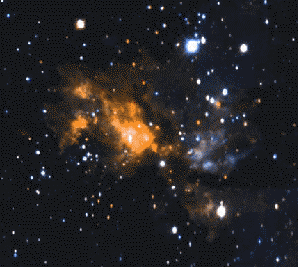NGC 2024 |
|

|
NGC 2024 is a star forming region located near the star Zeta Orionis in Orion's Belt. This JK composite, acquired with the twin-channel UCLA camera on the Lick 3-m telescope, reveals a dense cluster of young stars (reddish region in center) which is obscured at visible wavelengths by the nebula's dark central dust lane. For images like this one, the two infrared wavelengths are color-coded as if our eyes were sensitive to those wavelengths; J (1.2 um) = blue, K (2.2 um) = red, green is a median of the combined J and K images. This image is a mosaic of 50 images in J and 50 images in K. The field of view is 12.17 arcmin by 11.87 arcmin.
|
Cep A |
|

|
Cepheus A is a remarkable and complex star forming region. This JK color composite is a mosaic with a final image size of 4.65 arcmin by 4.80 arcmin. The bluish regions are optically visible, but the reddish nebula is only seen at infrared wavelengths. Polarization measurements reveal that the infrared nebula is due to scattered light from an invisible, highly obscured source near the center of the field.
|
S106 |
|

|
S106 is a well-known region of star formation dominated by a bi-polar outflow from a massive young star. The distribution of color in this JK composite reveals where the obscuration by a dusty disk is greatest.
|